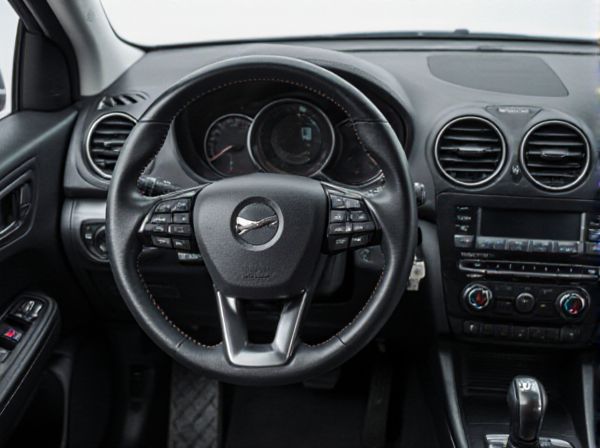
Photo illustration: Pivot Steering vs Ackermann Steering
Pivot steering offers precise control by allowing the vehicle to rotate around a fixed point, ideal for tight maneuvering in confined spaces. Ackermann steering improves cornering stability by aligning the wheels to follow concentric circles, reducing tire wear and enhancing handling on turns. Your choice between these systems depends on whether you prioritize maneuverability or smooth cornering performance.
Table of Comparison
| Feature | Pivot Steering | Ackermann Steering |
|---|---|---|
| Definition | Single-point steering with a pivot axis | Geometry-based steering ensuring correct wheel angles |
| Steering Mechanism | Central pivot allows front wheels to turn as one unit | Linkage aligns wheels for optimal turning radius |
| Turning Efficiency | Less efficient; inner wheel may slip | Highly efficient; reduces tire scrub and wear |
| Use Cases | Simple vehicles, some carts | Most modern cars and trucks |
| Advantages | Simple design, low cost | Improved handling, reduced tire wear |
| Disadvantages | Poor cornering precision | More complex design and maintenance |
Introduction to Vehicle Steering Mechanisms
Pivot steering enables vehicles, particularly in heavy machinery and agricultural equipment, to rotate around a central pivot point, allowing for zero-radius turns and enhanced maneuverability in confined spaces. Ackermann steering, commonly found in passenger cars, utilizes a geometry that ensures the inner wheels turn at a sharper angle than the outer wheels during cornering, reducing tire slippage and improving handling. Both steering mechanisms optimize vehicle control and turning performance by addressing different operational requirements and terrain conditions.
Overview of Pivot Steering Systems
Pivot steering systems use a central pivot point allowing the vehicle to rotate around it, providing tight turning radii ideal for compact or heavy machinery. This system enhances maneuverability in confined spaces by enabling the wheels or entire frame to pivot simultaneously. Pivot steering is commonly employed in forklifts, skid-steer loaders, and agricultural equipment where precise, sharp turns are essential.
Fundamentals of Ackermann Steering Geometry
Ackermann steering geometry is designed to reduce tire slip during cornering by ensuring that the inner and outer wheels trace concentric circles with different radii, aligning the steering angles accordingly to the vehicle's turning radius. This fundamental concept centers on the geometric relationship between the front wheels and the steering linkage, optimizing traction and minimizing tire wear. Unlike pivot steering, which rotates the entire vehicle around a fixed point, Ackermann steering precisely controls wheel angles to enhance stability and handling on paved surfaces.
Key Differences Between Pivot and Ackermann Steering
Pivot steering uses a central pivot point allowing the front wheels to rotate around a fixed axis, enabling tight turns ideal for compact maneuvering. Ackermann steering geometry aligns the front wheels at different angles during turns to minimize tire slip and improve cornering stability by ensuring each wheel follows its proper turning radius. The key distinction lies in pivot steering's simplicity and tight radius advantage versus Ackermann's focus on tire wear reduction and handling precision in automobiles.
Advantages of Pivot Steering in Modern Vehicles
Pivot steering offers enhanced maneuverability in tight spaces by allowing wheels to rotate around a central pivot point, significantly reducing turning radius compared to Ackermann steering. This system improves vehicle stability during low-speed turns and off-road conditions, making it ideal for modern electric and autonomous vehicles requiring precise control. Furthermore, pivot steering reduces tire wear by minimizing scrubbing, leading to increased durability and lower maintenance costs.
Benefits of Ackermann Steering for Maneuverability
Ackermann steering geometry enhances maneuverability by ensuring that each wheel follows the correct radius when turning, reducing tire slip and improving traction. This design allows for tighter turning circles and smoother cornering, especially beneficial in low-speed or confined environments. The alignment of wheels optimizes steering response, leading to increased precision and control in various driving conditions.
Applications of Pivot Steering in Various Industries
Pivot steering, characterized by its ability to rotate around a central pivot point, is extensively applied in industries requiring precise maneuverability in tight spaces, such as agriculture with pivot irrigation systems and construction with skid-steer loaders. Its application in warehouse robotics and automated guided vehicles enhances navigation efficiency in confined environments, optimizing material handling and operational workflows. The technology's adaptability to rugged terrains and complex environments makes it ideal for off-road machinery and military vehicles, improving control and reducing turning radius in challenging conditions.
Common Uses of Ackermann Steering in Automobiles
Ackermann steering geometry is predominantly used in passenger cars and light trucks to improve tire grip and reduce tire wear during cornering by ensuring that all wheels follow concentric circular paths. This steering mechanism enhances handling stability and minimizes tire scrubbing, making it ideal for typical road conditions and urban driving. In contrast, pivot steering is often reserved for specialized vehicles like forklifts or tractors where zero turning radius is prioritized over high-speed maneuverability.
Performance Comparison: Pivot vs Ackermann Steering
Pivot steering offers exceptional maneuverability with zero turning radius, enabling tight turns and precise navigation, ideal for vehicles operating in confined spaces. Ackermann steering, optimized for stability and tire wear at higher speeds, provides smoother cornering by aligning wheels to follow circular paths, reducing lateral slip. Performance-wise, pivot steering excels in low-speed agility, while Ackermann steering dominates in efficiency and control during high-speed or long-distance driving.
Choosing the Right Steering System for Your Needs
Pivot steering offers superior maneuverability in tight spaces, making it ideal for agricultural machinery and off-road vehicles requiring precise directional control. Ackermann steering excels in on-road applications by reducing tire scrub and improving cornering stability, favored in passenger cars and light trucks. Choosing the right steering system depends on operational environment, vehicle type, and the necessity for either tight turning radius or enhanced road handling.
 caratoz.com
caratoz.com